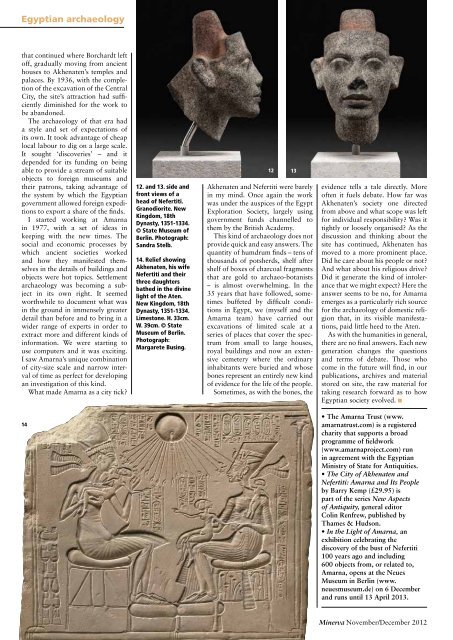Following Odysseus Not the end of the world Amarna city of light ...
Following Odysseus Not the end of the world Amarna city of light ...
Following Odysseus Not the end of the world Amarna city of light ...
- No tags were found...
Create successful ePaper yourself
Turn your PDF publications into a flip-book with our unique Google optimized e-Paper software.
Egyptian archaeologythat continued where Borchardt left<strong>of</strong>f, gradually moving from ancienthouses to Akhenaten’s temples andpalaces. By 1936, with <strong>the</strong> completion<strong>of</strong> <strong>the</strong> excavation <strong>of</strong> <strong>the</strong> CentralCity, <strong>the</strong> site’s attraction had sufficientlydiminished for <strong>the</strong> work tobe abandoned.The archaeology <strong>of</strong> that era hada style and set <strong>of</strong> expectations <strong>of</strong>its own. It took advantage <strong>of</strong> cheaplocal labour to dig on a large scale.It sought ‘discoveries’ – and itdep<strong>end</strong>ed for its funding on beingable to provide a stream <strong>of</strong> suitableobjects to foreign museums and<strong>the</strong>ir patrons, taking advantage <strong>of</strong><strong>the</strong> system by which <strong>the</strong> Egyptiangovernment allowed foreign expeditionsto export a share <strong>of</strong> <strong>the</strong> finds.I started working at <strong>Amarna</strong>in 1977, with a set <strong>of</strong> ideas inkeeping with <strong>the</strong> new times. Thesocial and economic processes bywhich ancient societies workedand how <strong>the</strong>y manifested <strong>the</strong>mselvesin <strong>the</strong> details <strong>of</strong> buildings andobjects were hot topics. Settlementarchaeology was becoming a subjectin its own right. It seemedworthwhile to document what wasin <strong>the</strong> ground in immensely greaterdetail than before and to bring in awider range <strong>of</strong> experts in order toextract more and different kinds <strong>of</strong>information. We were starting touse computers and it was exciting.I saw <strong>Amarna</strong>’s unique combination<strong>of</strong> <strong>city</strong>-size scale and narrow interval<strong>of</strong> time as perfect for developingan investigation <strong>of</strong> this kind.What made <strong>Amarna</strong> as a <strong>city</strong> tick?12. and 13. side andfront views <strong>of</strong> ahead <strong>of</strong> Nefertiti.Granodiorite. NewKingdom, 18thDynasty, 1351-1334.© State Museum <strong>of</strong>Berlin. Photograph:Sandra Stelb.14. Relief showingAkhenaten, his wifeNefertiti and <strong>the</strong>irthree daughtersba<strong>the</strong>d in <strong>the</strong> divine<strong>light</strong> <strong>of</strong> <strong>the</strong> Aten.New Kingdom, 18thDynasty, 1351-1334.Limestone. H. 33cm.W. 39cm. © StateMuseum <strong>of</strong> Berlin.Photograph:Margarete Busing.12 13Akhenaten and Nefertiti were barelyin my mind. Once again <strong>the</strong> workwas under <strong>the</strong> auspices <strong>of</strong> <strong>the</strong> EgyptExploration Society, largely usinggovernment funds channelled to<strong>the</strong>m by <strong>the</strong> British Academy.This kind <strong>of</strong> archaeology does notprovide quick and easy answers. Thequantity <strong>of</strong> humdrum finds – tens <strong>of</strong>thousands <strong>of</strong> potsherds, shelf aftershelf <strong>of</strong> boxes <strong>of</strong> charcoal fragmentsthat are gold to archaeo-botanists– is almost overwhelming. In <strong>the</strong>35 years that have followed, sometimesbuffeted by difficult conditionsin Egypt, we (myself and <strong>the</strong><strong>Amarna</strong> team) have carried outexcavations <strong>of</strong> limited scale at aseries <strong>of</strong> places that cover <strong>the</strong> spectrumfrom small to large houses,royal buildings and now an extensivecemetery where <strong>the</strong> ordinaryinhabitants were buried and whosebones represent an entirely new kind<strong>of</strong> evidence for <strong>the</strong> life <strong>of</strong> <strong>the</strong> people.Sometimes, as with <strong>the</strong> bones, <strong>the</strong>evidence tells a tale directly. More<strong>of</strong>ten it fuels debate. How far wasAkhenaten’s society one directedfrom above and what scope was leftfor individual responsibility? Was ittightly or loosely organised? As <strong>the</strong>discussion and thinking about <strong>the</strong>site has continued, Akhenaten hasmoved to a more prominent place.Did he care about his people or not?And what about his religious drive?Did it generate <strong>the</strong> kind <strong>of</strong> intolerancethat we might expect? Here <strong>the</strong>answer seems to be no, for <strong>Amarna</strong>emerges as a particularly rich sourcefor <strong>the</strong> archaeology <strong>of</strong> domestic religionthat, in its visible manifestations,paid little heed to <strong>the</strong> Aten.As with <strong>the</strong> humanities in general,<strong>the</strong>re are no final answers. Each newgeneration changes <strong>the</strong> questionsand terms <strong>of</strong> debate. Those whocome in <strong>the</strong> future will find, in ourpublications, archives and materialstored on site, <strong>the</strong> raw material fortaking research forward as to howEgyptian society evolved. n14• The <strong>Amarna</strong> Trust (www.amarnatrust.com) is a registeredcharity that supports a broadprogramme <strong>of</strong> fieldwork(www.amarnaproject.com) runin agreement with <strong>the</strong> EgyptianMinistry <strong>of</strong> State for Antiquities.• The City <strong>of</strong> Akhenaten andNefertiti: <strong>Amarna</strong> and Its Peopleby Barry Kemp (£29.95) ispart <strong>of</strong> <strong>the</strong> series New Aspects<strong>of</strong> Antiquity, general editorColin Renfrew, published byThames & Hudson.• In <strong>the</strong> Light <strong>of</strong> <strong>Amarna</strong>, anexhibition celebrating <strong>the</strong>discovery <strong>of</strong> <strong>the</strong> bust <strong>of</strong> Nefertiti100 years ago and including600 objects from, or related to,<strong>Amarna</strong>, opens at <strong>the</strong> NeuesMuseum in Berlin (www.neuesmuseum.de) on 6 Decemberand runs until 13 April 2013.Minerva November/December 2012
















